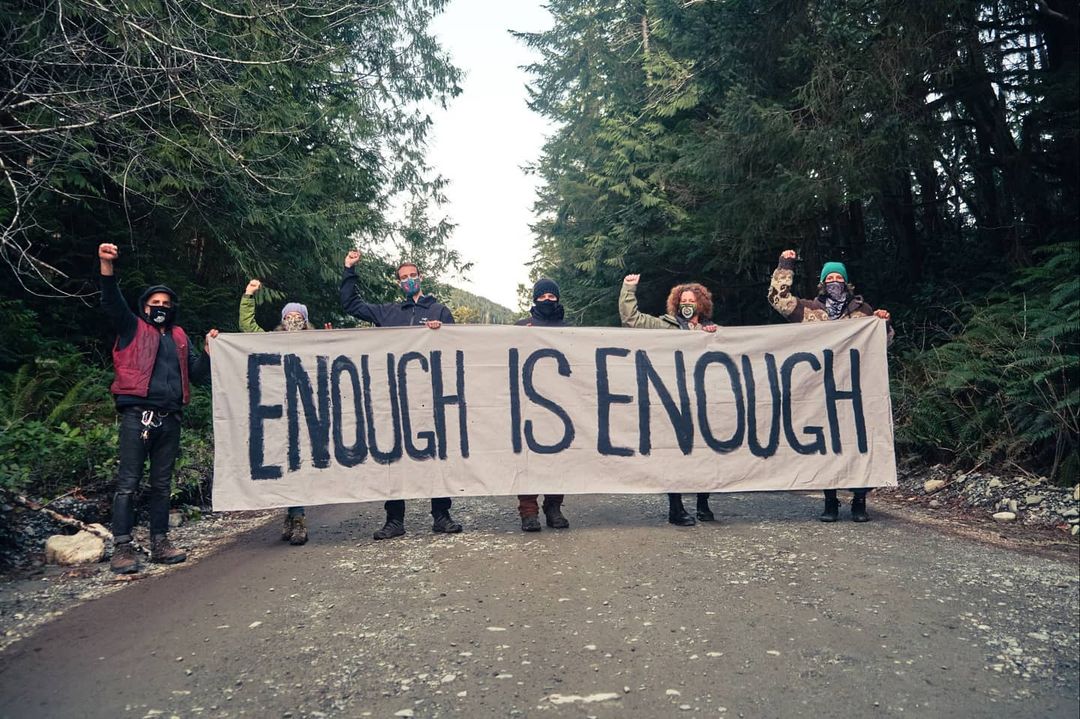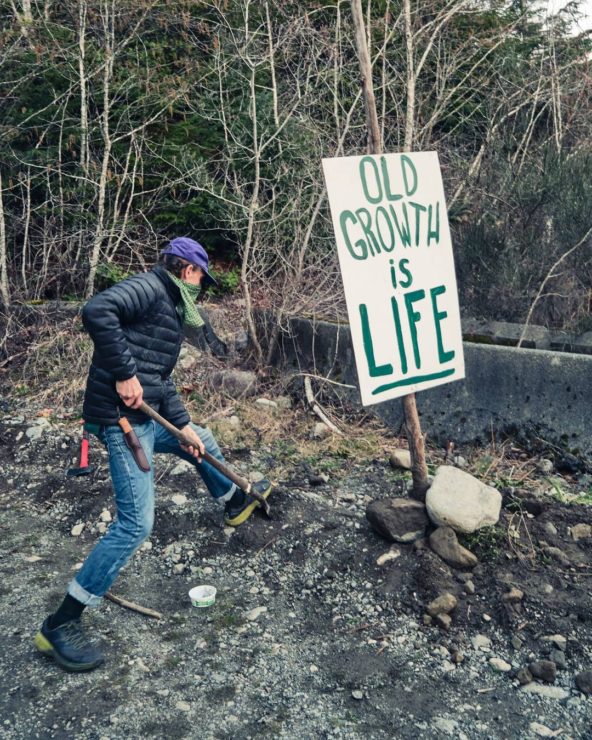Eight months and nine locations later, a rotating cast of forest defenders continue to join those that have been there from day one

On April 1, The B.C. Supreme Court issued a police-enforceable injunction to the Teal-Jones Group against the Fairy Creek forest defenders. Those on the frontlines are disappointed, but they aren’t giving up. Blockaders at Fairy Creek plan to sit tight, and those fighting from home say they will continue to put pressure on the government to stop old growth logging.
The injunction was served at all camps on the morning of April 6.
Organizers are expecting — and preparing for — the RCMP to come at any moment. Meanwhile, the blockade continues to swell with support and has spawned several others: there are currently nine major flashpoints ranging all over the southern part of Vancouver Island.
The Rainforest Flying Squad is a group of tight-knit volunteers that conduct frequent pop-up blockades that slow and frustrate the efforts of old growth loggers. A blockade at Caycuse, established in the early hours of Sunday, April 4, turned around an early-morning logging operation.
Bobby Arbess is a direct-action organizer and the only forest defender specifically named in the Teal-Jones injunction. He is surprised that it took so long to get to this point.
“We were expecting an injunction maybe two or three days [after the first blockade], but for some reason it took the company eight months,” said Arbess.
Arbess is a veteran organizer, with a long history of old growth conservation dating back to 1991 actions in the Walbran Valley and 1993 “war in the woods” at Clayoquot Sound.

“We can’t be at a more critical stage in this struggle without having lost entirely,” said Arbess.
The fight for ancient forests became viscerally real for Arbess in his twenties when he was planting monoculture tree saplings to replace the towering old growth forests that have gone the way of the saw mill.
“It became very clear that there was an industrial experiment happening at a grand scale to replace ecosystems that have essentially evolved undisturbed for ten thousand years,” he said.
A summary of the situation
The overall situation is complicated. These actions are part of a larger action that seeks to preserve old-growth forests at risk of logging in B.C. Some associated with the movement are calling on the logging industry to transfer its skills to second-growth logging and Indigenous collaboration on resource projects.
However, Teal-Jones has a revenue-sharing agreement with the province, which means that the Pacheedaht nation — where the Fairy Creek watershed is located — is compensated for logging in its territory.
Upon occupation, the Fairy Creek blockade movement was criticized for taking action without consent from the Pacheedaht nation. While Pacheedaht Elder Bill Jones has been a prominent supporter, he is the only member of his nation actively involved with the occupation. The tribal council has stayed silent regarding the settler-initiated and settler-led movement, although some forest defenders believe that the revenue-sharing agreement bars the Pacheedaht from showing support even if they wanted to.
“[We] fully support the First Nations and allies who are protesting the negligent logging and clear-cutting practices enabled by the BC government,” wrote The Union of British Columbia Indian Chiefs, in a formal resolution concerning old growth logging in Indigenous territories.
The latest action at Caycuse on April 4 was supported by some members of the neighbouring Ditidaht nation.
“We’re in the midst of a climate emergency,” said Arbess. “[The] provincial government has a climate action plan that doesn’t address what is happening to the forests. We have a forest policy that doesn’t acknowledge the climate emergency. Somehow we have to start connecting the dots. This movement is about making that happen.”
A view of the frontlines

The Martlet visited two of the most established camps that are putting themselves in between Teal-Jones and the Fairy Creek watershed. The ‘Headquarters’ is situated at the sea-level entrance of the logging road leading up to the Fairy Creek watershed, and River Camp is a smaller, winterized location that sits on the fork of two roads, which remain unfinished due to the efforts of blockaders.
The road in between the two is a seven kilometre stretch of logging road, flanked by clearcut fields of tree stumps. It is filled with a variety of campers including children playing with Lego and their families, university students, and grizzled veterans of the Clayoquot Sound protests.

At the blockade entrance for Fairy Creek, forest defenders check-in for COVID-19 tracing purposes and are reminded to wear masks and follow camp protocols. Otherwise, it’s a free-flowing environment, with many small campfires dotting the seven kilometers from the camp headquarters to river camp, all fueled from wood scavenged from the unwanted scraps left behind by industrial logging.
“It’s ironically keeping us warm,” said Emily*, who drove up to River Camp in an old school bus that used to be a mobile daycare centre around Powell River. The bus is now been christened as the “OrcaBus” and repurposed for blockading. On a first glance of the exterior, the old daycare graphics blend in with the newer, hand painted climate action art that reads: “planning together to build leaders for tomorrow.”


The long winding road of campers is intentional. It serves as a COVID-19 safety measure, and also as seven kilometres of non-violent impedance for RCMP when they arrive, said Shawna Knight, who asked the Martlet not to reveal the specific strategies in place.
“We’re not reinventing the wheel,” said Knight, referring to some of the tactics used in the Clayoquot Sound protests back in 1993. “Our tactic is to hold space, stall, and keep the RCMP from hitting the next camp with whatever pageantry and theatrics we can pull off,”
Many at the camp sympathize with those whose livelihoods are being affected, and make a distinction between fighting for old growth and supporting the logging industry’s direction towards sustainable and second-growth logging.
Elizabeth Waite had been following the Fairy Creek Instagram for some time and decided to book four days off work to come visit and support.
“Honestly, those four days changed my life,” said Waite. “I just couldn’t live with myself if I wasn’t up here fighting for what I believed in.”
After her first trip, Waite went back to the Sunshine Coast, quit her job, broke up with her boyfriend and moved out to be at the blockade. She is planning to be there for as long as people are needed on the front.
“I just feel so humbled to be in this forest and to just be part of this movement,” said Emily, a frequent camper with her two young children. “I can’t imagine just walking away right now.”
*Some blockade participants requested their last name be omitted from this article out of fear of retribution for their involvement with the blockade.















